Where Wellness Meets the Wilderness
#GetOutside
Enjoy the great outdoors in Yellowstone National Park to improve your health and wellbeing
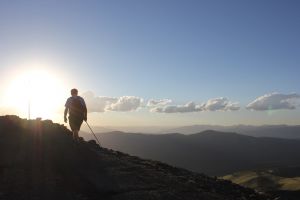
Imagine going to your doctor about high blood pressure and stress and leaving with a prescription to spend time outside. It sounds farfetched, but more than 400 current studies show spending time in nature can improve your health and well-being — doing everything from helping reduce stress, anxiety, and depression to lowering inflammation, calming the mind, and increasing happiness. Ancient medical systems, including Ayurveda and Chinese medicine, encourage time in nature as a form of healing. In the U.S. in the early 20th century, doctors sent well-heeled Americans to private sanatoriums away from the hustle and bustle of city life to reduce stress and improve mental health. Since the 1980s, doctors in Japan have been writing prescriptions for patients to engage in shinrin-yoku, which translates to “forest bathing,” aka spending time outside in nature.
How about hitting Yellowstone National Park instead of a spa or yoga retreat for a wellness vacation?
Bigger than Delaware and Rhode Island combined, Yellowstone’s 2.2 million acres are the heart of the Greater Yellowstone Ecosystem, which is one of the largest nearly intact temperate-zone ecosystems on Earth. “I always think of Yellowstone as a place that puts you in the present moment,” says Lori Todd, who has been exploring Yellowstone for about 25 years and is currently Communications Manager for Yellowstone National Park Lodges. “You’re surrounded by beauty and wonder and not worrying about yesterday or the future like so many of us do during our normal daily lives. Yellowstone is a gift as it can cultivate inner peace and joy so effortlessly.”
A trip to Yellowstone, the world’s first national park, isn’t a miracle cure, but it offers almost infinite opportunities to improve your wellness. Here are a few ideas.
Walk to Wellness
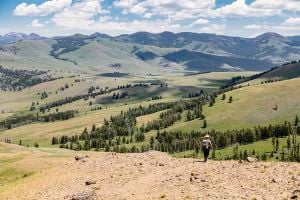
A study published in a 2011 issue of Health and Place showed that for middle-aged adults, a one-hour rural walk improved their mental outlook and was more cognitively restorative than an urban walk of the same length. The Trails Through Yellowstone package includes four days of hiking — and wildlife watching — with a field educator from Yellowstone Forever. Hikes will be up to 8 miles long and include up to 1,500 feet of vertical ascent. To ensure each day’s hike caters to the group’s interests while also considering weather and trail conditions, specific hikes are not set in advance but may include Mount Washburn, Clear Lake, Slough Creek, Avalanche Peak, or Pelican Valley. Over the four days, expect the hikes to explore the diversity of landscapes within Yellowstone — from geothermal features to the high alpine terrain and lakes.
Water and Wellness
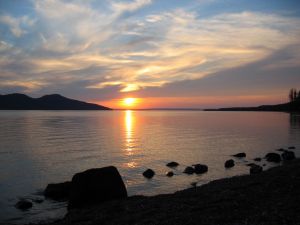
If you want to work on your wellness while on the water, Yellowstone National Park is home to more than 600 lakes and ponds and about 1,000 rivers and streams. Yellowstone Lake isn’t only the largest lake in the park, but also the largest lake above 7,000 feet in elevation in North America (at 7,733 feet above sea level). Swimming in Yellowstone Lake isn’t recommended — the average water temperature is 41 degrees Fahrenheit — but you can take guided fishing and sightseeing trips there. The lake has the continent’s largest wild population of cutthroat trout and also a significant population of lake trout. Sightseeing trips are a great way of visiting more areas of the lake. On guided trips, captains can create an itinerary based on what you want to see. Both fishing and sightseeing trips depart from Bridge Bay Marina.
Picture Perfect Wellness
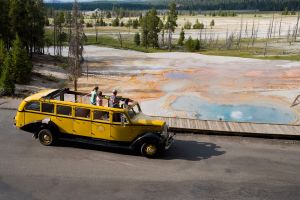
Historic Yellow Bus tour
The guided photo safari will immerse you in the park’s natural wonders while also offering the opportunity to learn something new or improve your existing skills. According to Psychology Today, trying something new helps build flexible thinking, which is part of mental wellness. The professional photographer/guide on each safari can help everyone from beginning photographers using their phones all the way up to shutterbugs with DSLR cameras.
Winter Wellness
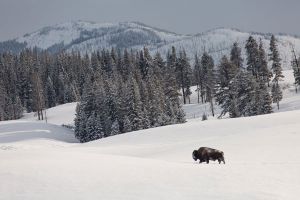
The park’s winter season — from mid-December through mid-March — is its least busy: In 2023, more than 4.5 million people visited Yellowstone, but only about 150,000 of these came during the winter. The park receives an average of more than 10 feet of snow, so you can rent Nordic skis and snowshoes at Old Faithful Snow Lodge and Mammoth Hot Springs and explore on your own. For a more immersive experience, take a half or full-day cross-country and snowshoe tour from Old Faithful Snow Lodge and Mammoth Hot Springs Hotel.
Maximum Wellness
“When I think about wellness, I think about quietude and slowing down,” Todd says. She shares her tips for maximizing Yellowstone’s effects on her well-being.
- Stay longer. The average visitor to Yellowstone spends one day in the park. “If that’s all the time you have, one day is better than not seeing Yellowstone at all, but, to me, squeezing too much into a short timeframe can be counterproductive to wellness — it can be stressful,” Todd says. “If you want to see all of Yellowstone’s main highlights, I recommend three to five days. But, if one day is what you have, I’d recommend picking just one particular area and letting yourself relax and enjoy it rather than trying to do the whole park.”
- Hit the lobby. A few of the park’s main hostelries have live music in their lobbies. “I love watching the talented musicians and also being a part of the community of visitors enjoying the park,” she says.
- Embrace being disconnected. Most of Yellowstone does not have super reliable cell service. “This can stress you out or you can enjoy it,” Todd says. “I think a lot of visitors might find it inconvenient at first, but then come to enjoy it.”
- Get an early start. Popular sites and trails — and the park’s roads — are less busy and congested in the morning.
- Seek out quieter areas on the trail or by the water. Yellowstone has more than 250 trails that together offer 1,000+ miles of hiking. There are also wonderful picnic areas and spots along rivers and creeks where you can bring a book, hang a hammock, or toss a blanket on the ground and absorb the negative ions coming off the water, which are known to relieve stress and boost energy. Ask at visitor centers or your hotel’s front desk/concierge for ideas.
Written by Dina Mishev
Dina Mishev is the editor-in-chief of Jackson Hole magazine.
For A World of Unforgettable Experiences® available from Xanterra Travel Collection® and our sister companies, visit xanterra.com.
Want to experience Yellowstone in-depth? See what makes Yellowstone National Park a great place to work for a season or longer!